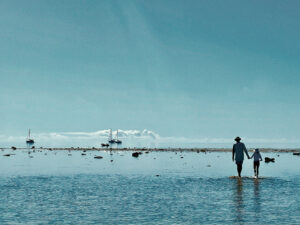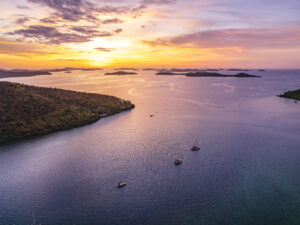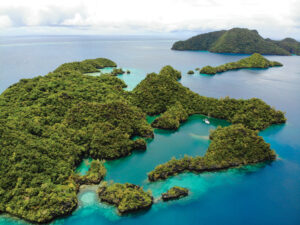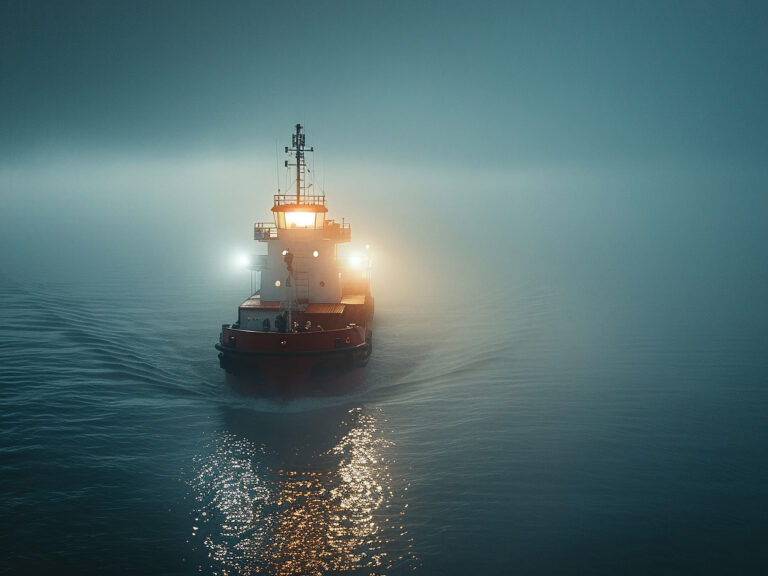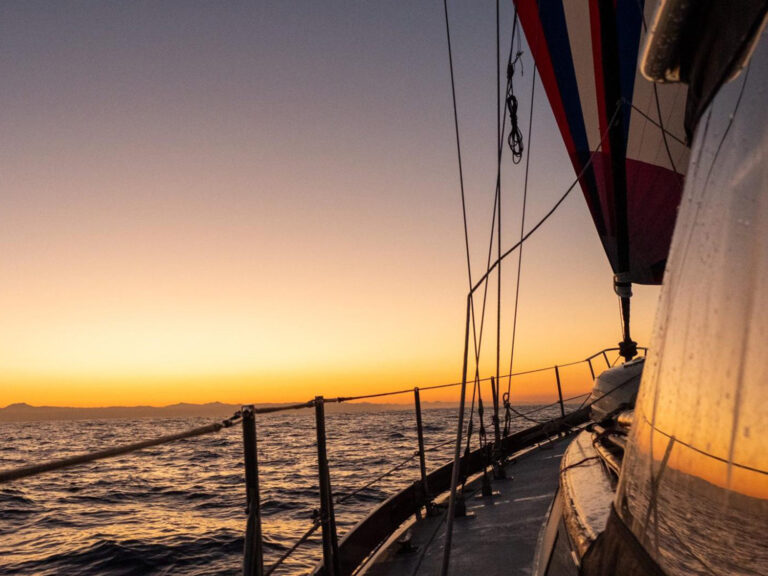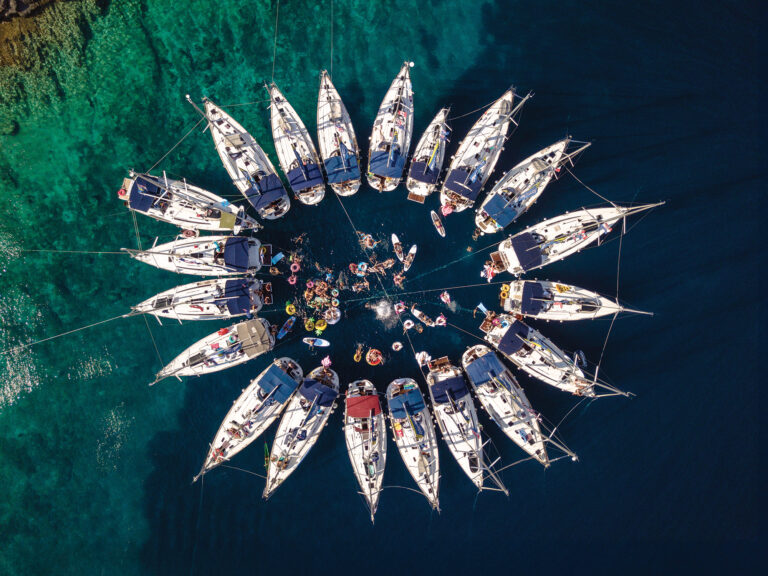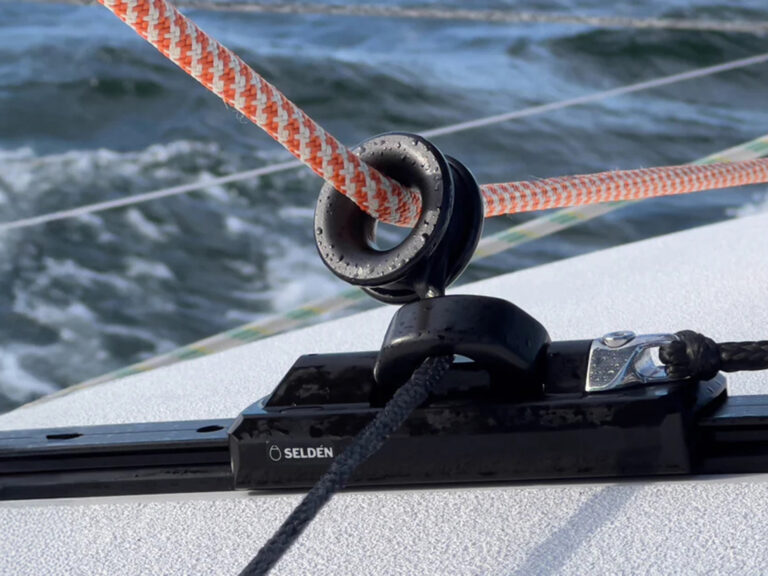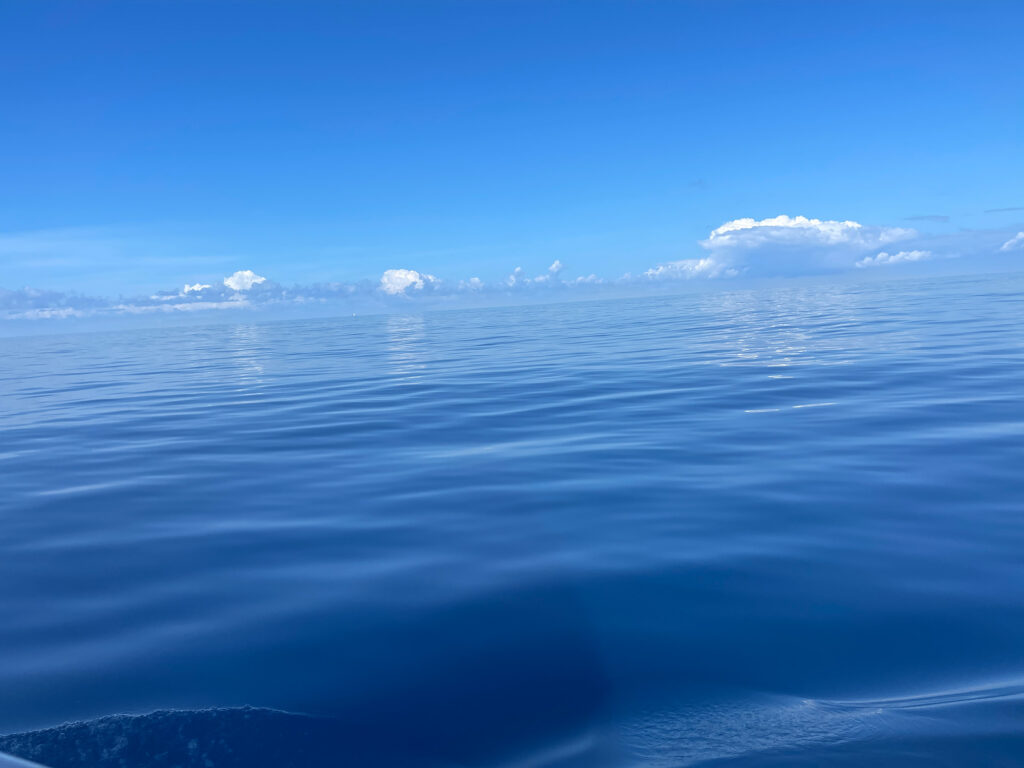
Someone has stolen the trade winds.
It’s Easter Weekend, and I’m aboard Strider, Richard Thomason’s Reliance 44 cutter. We are anchored in Tyrell Bay on the small island of Carriacou. It’s been windless for days. Don Street writes that it’s just a “typical April calm,” but this lack of an easterly breeze has also stolen the natural air conditioning we’ve come to expect in the West Indian Islands.
So, it’s also hot. Yesterday, the temperature on deck was 94. Below, it was in the high 80s. By mid-afternoon, with the boat anchored facing east, the cockpit was wide open to the afternoon sun. I found myself moving around in search of what little shade the Bimini top could afford. Everybody was complaining except Richard, who thrives in this heat. There was Sahara dust in the air, and it hadn’t rained in a month. The normally green hills were brown. April had become the new July.
Richard and I spent just two days on this laid-back island. We could have spent a month, but it was time to get moving. We both wanted to get to Antigua for the Classic Yacht Regatta at the end of the month. Time was a-wasting.
Monday, April 2
We were off the hook just as the sun peeked over the Carriacou hills. Both of us have data feeds on our iPhones. Richard is on AT&T. I‘m using Spectrum. He has access to PredictWind. I’m partial to Windy. We wrangled over which was better, but we had to agree: getting up to Bequia would not be easy.
The wind would be light today, northeast tomorrow—not conducive to sailing up-wind back to Bequia for fuel. But we could make Chatham Bay on the west side of Union Island. It’s only 8 miles. Under power, we were there by 10:15, tucked into the northern end of the cove, with the anchor down 20 feet in a sandy bottom. We’d lounge here until the wind became more favorable. It was time to take a swim in the clear water.
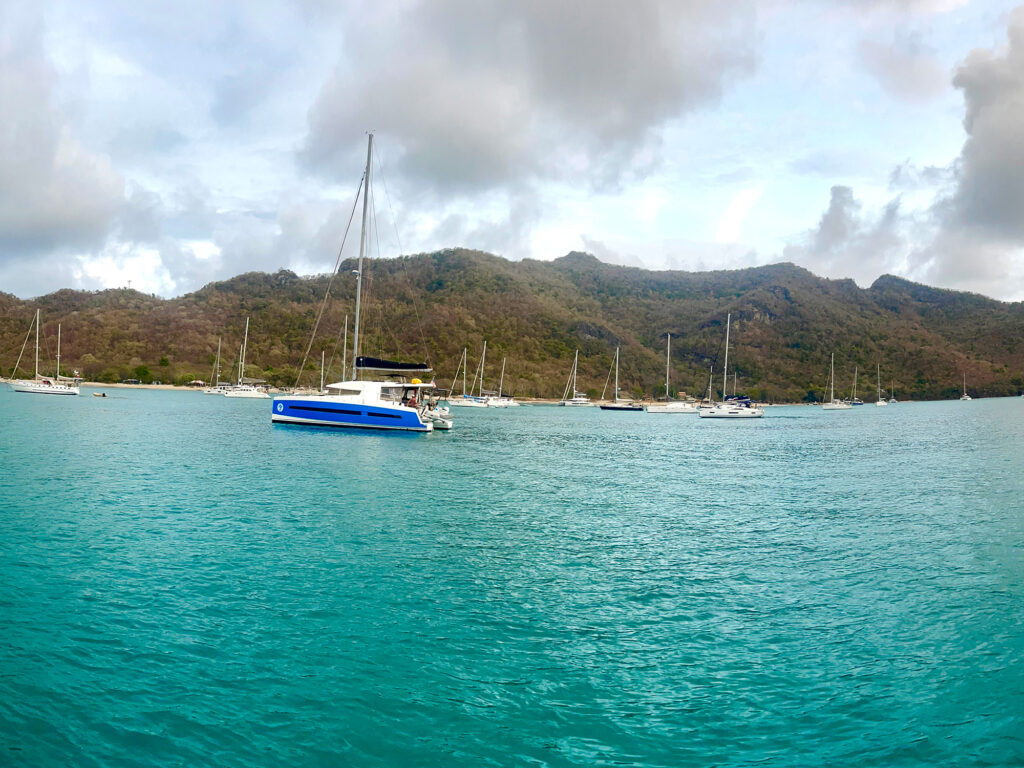
Chatham Bay is one of those anchorages you dream about. The hills descend to a gently curved beach, fringed by palms. There’s not a vacation home in sight, no condos or adult-only resorts, just a scattering of beach bars and barbecue shacks catering to the visiting charter guests who drop in. There is a dirt road over the hills into town, but a few years ago, Chatham Bay was isolated, accessible only by foot or boat.
Hiking trails take you to lookouts above the bay, where the entire Grenadines spreads out before you. When we arrived, there were just two other boats anchored in the cove—by evening, two dozen had arrived. As the sun set, a beach bar was pumping out loud music, and crews were heading in for another night of partying.
We were tempted to join them, but since we were “just waiting for a wind shift,” we had foregone the formality of clear-in at Clifton. We were here “in transit.”
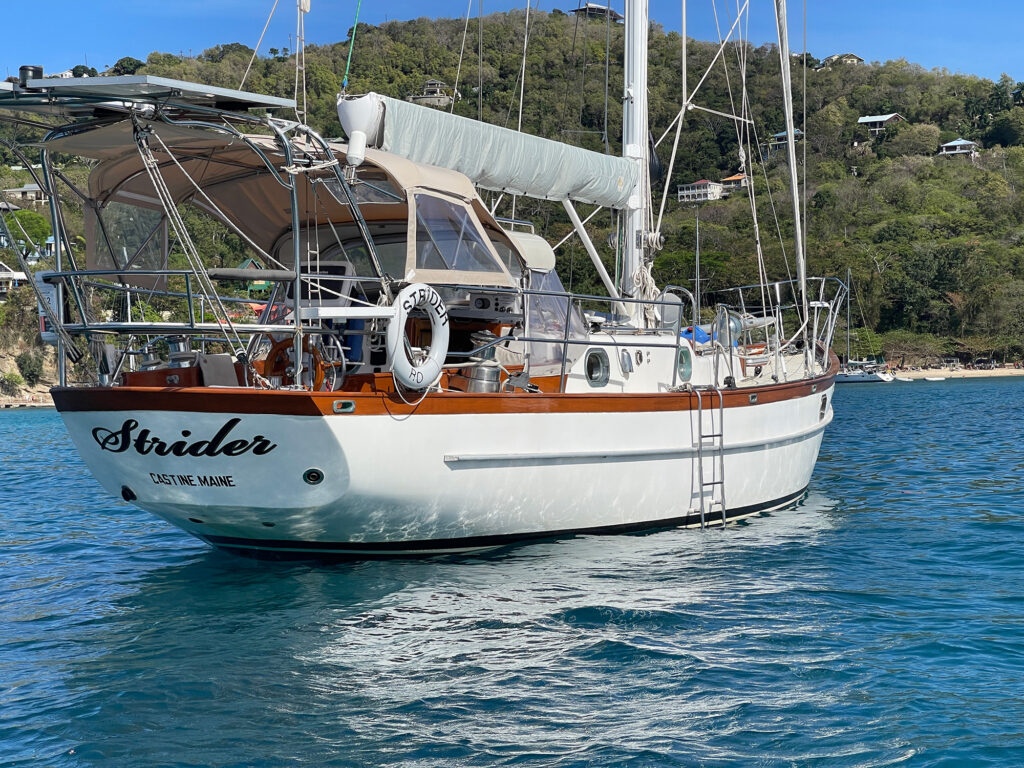
Tuesday, April 3
As we left the lee of Union Island, the morning northeast wind appeared slightly more favorable, but fetching Bequia was still going to be rough. If we managed to make 4 knots, it would take us six hours to cover the 25 miles.
Then there was a west-setting current of a knot. In 10 hours, that would push us 6 miles west of our course, not to mention any leeway. The wind was forward of the beam, and the seas were on the bow. It was slow going and wet.
We shouldered on.
It was a pleasure to watch a man sail his boat. Richard had been single-handing Strider for a few years, and he knew intuitively what the boat needed and liked. He tucked in a reef on the main and tweaked the head sail, which reduced the weather helm. It’s a one-man job. He left me to tend the helm.
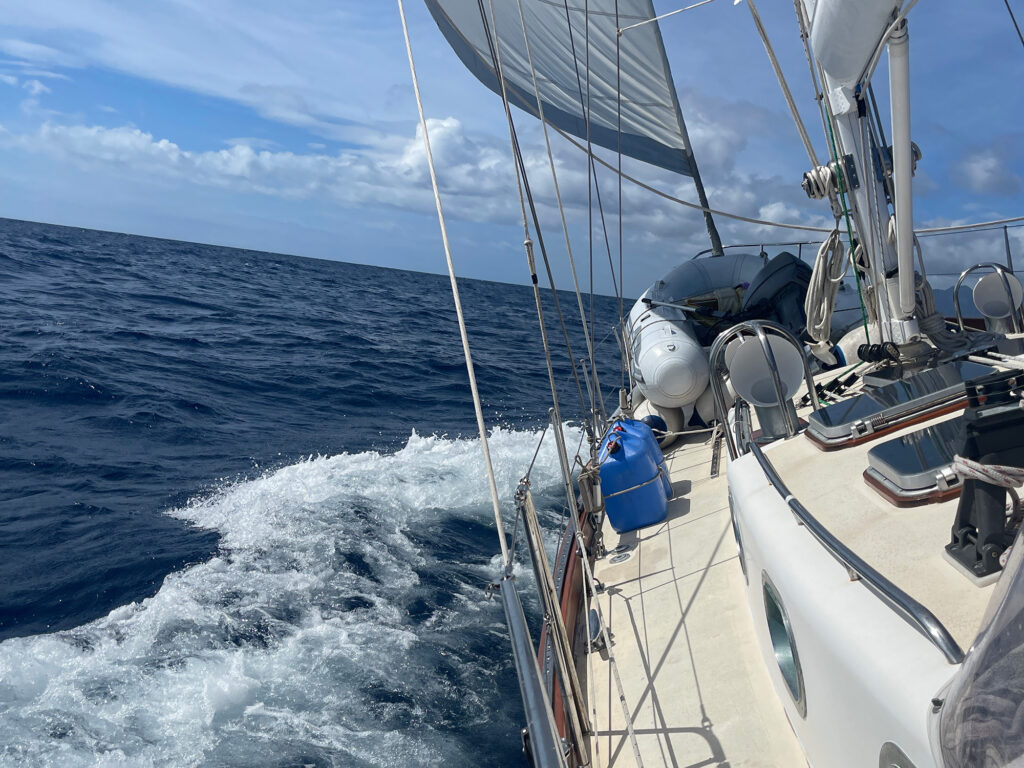
The boat settled down on a northerly tack. We had most of the day with little to do, so he and I got to talking about the boats we’ve owned and the women we’ve loved.
“Strider was built in Montreal in 1992,” he said. “She’s a 44-foot hand-laid fiberglass cutter designed by Pierre Munier and built by Reliance Sailing Craft Co., Ltd. They built 44 of them, starting in the late ’70s through the mid-’90s.
“There are still quite a few of them around,” he continued. “I know of two. I found this one down in North Carolina, just before Covid. It had been neglected for a while, so I cleaned her up and brought her home to Maine. I spent a good year refitting her. I replaced the engine, removed all of the plastic teak from the deck, installed non-skid decking, and then stripped and revarnished the brightwork. I removed years’ worth of bottom paint and painted the topsides. I tore out a lot of wiring, went through all the systems, and spent money and time replacing or updating all the electronics. Now, the autopilot, chart plotter, radios—everything is integrated. Afterwards, there was a lot of cleaning and painting.”
“You’re not finished?” I asked.
“There is still a lot to do,” he said. “I have to get back to Maine for the summer.”
“Did you have to redo any of the cabin work?”
“No. The original owner, a cabinetmaker from Toronto, did a fantastic job below.”
To this, I had to agree. The interior has hand-rubbed, varnished teak and off-white cream accents. The forward stateroom has a V-berth with an opening hatch overhead, along with lockers and drawers for stowage. The main cabin has a U-shape dining table opposite a settee. The nav station is across from the galley, which has a three-burner stove, oven, refrigerator, freezer and dual sink. Aft are head and hanging locker for wet foulies. Adjacent to the companionway are two berths, port and a starboard, one with a door and vanity. Richard uses the starboard berth, which has a draw curtain, as his toolshed.
Strider is indeed a well-put-together boat. On the exterior, the stem has a graceful angle that leads down to the water, while the sheer sweeps elegantly from the bow to the stern. The transom is flat with just the right space for the nameplate and home port.
“She handles well,” I said from the helm.
Richard tucked himself into the forward end of the cockpit to leeward. “She’ll do 6 knots, constantly, even 7, maybe a little over 7,” he said.
This is what I was experiencing, plus Strider is fairly comfortable in the seaways. She does not bounce.
“She’s a heavy boat,” he added. “She has a long keel and an entrapped prop. The rudder is hung off the aft end of the keel.
“I hesitate to say it,” he said with a pause, “but I’ve never had a problem picking up trap lines. She sails right over them. But she has her drawbacks. I suppose every boat does. She’s wet. The helmsman catches spray in a good blow, so I had new canvas and side curtains made. She’s so well fitted together that it can be a chore to access anything.”
“What are the things you like about the boat?” I asked.
“I like that everything’s set up for single-handed sailing,” he replied. “All of the halyards, sheets and furling lines lead directly back into the cockpit. Everything’s right at your fingertips. There’s a button to push to furl or unfurl the jib. When I first sailed her, I did have a problem with the in-boom furling. The boom needs to be exactly perpendicular to the mast for the battened sail to wind in properly. Once I fix the vang, it works perfectly. The main sail is old, and occasionally the bolt rope slips out of the groove going up the mast. It’s critical not to be furling or reefing in 30 knots of wind.”
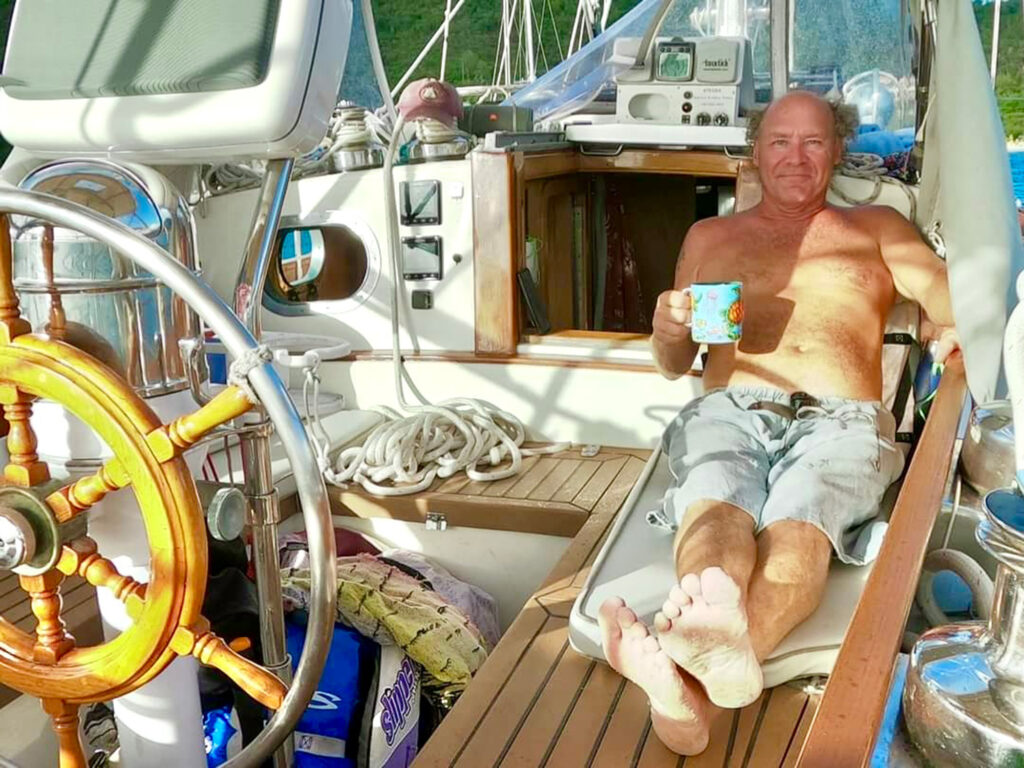
Richard then sat in silence for a while before adding: “She’s certainly not a super-expensive or fancy yacht, but she’s really, really nicely laid out, nicely put together. She turns heads wherever she goes. I get compliments in every harbor. ‘Beautiful,’ they tell me.
She is a beautiful boat.”
“But you still want to sell it?” I asked.
“I do.”
“Why?”
”It’s not really the boat I want to live on for the rest of my life,” he said.
Sure, it might be nice to have a boat that requires less work, but why own a boat if not to take care of it? A man needs something to work on—something requiring physical work—with his hands and tools. The intellect can sit back and watch as something wonderful comes to life, like the shape of a piece of wood or the glow of a well-laid coat of varnish. It brings balance to life.
But Richard makes his living with his hands. He’s a builder and renovator of wealthy people’s summer homes in Maine.
“Be nice to have a midship cockpit,” he says, “and a large bed in the aft cabin.”
I’ve owned four sailboats over 50 years. They each required a lot of work, money and time, especially the two wooden ones. When I bought my last boat, Searcher, a 57-foot Bowman ketch, she was already 20 years old and had more systems than I needed for cruising. I tore them out and kept only the basics.
On Searcher’s last voyage through these islands, 14 years ago, we hand-steered—all the way down, back and through the islands. The out-of-date autopilot was too expensive to replace. We had $700 worth of ice instead of $5,000 worth of new refrigeration. Even those things felt like conveniences. During my earlier voyages in these islands, before chart plotters, I relied on a sextant, a hand-bearing compass and a log to plot dead-reckoning positions. In the late 1990s, I found one of the first Garmin GPS receivers. It was easier than taking noon sights, better than Loran and even better than the first satellite receivers that took four hours to calculate a fix. I was still using paper charts in those days. On more recent deliveries, I have relied on Navionics on my smartphone.
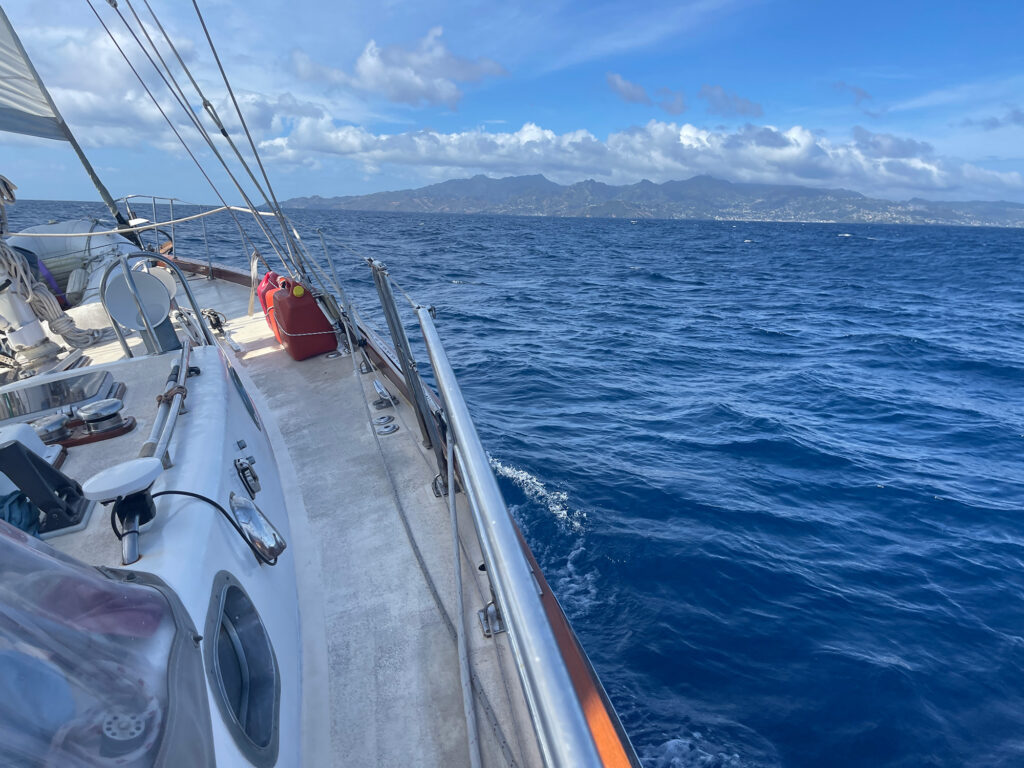
Back to sailing on Striker: Our course up to Bequia would have been a pleasant romp in a southeasterly breeze, but this was a strange season. It was a day of hard, wet work fighting our way to Bequia. Strider was making progress against the wind and seas, with spray over the bow. Occasionally, the lee scuppers would fill, and I was getting wet hand-steering for most of the day, fore-reaching.
It was late afternoon when we finally arrived in Admiralty Bay’s inner harbor. First things first: ashore for a shower, laundry and a rum punch at Daffodils’s bar. Over 20 years, this establishment has become a restaurant and bar with rooms to rent and a floating filling station.
The next morning, April 4, while Richard was at the post office officially clearing us in and out of St. Vincent and the Grenadines, I was at the ATM extracting more Eastern Caribbean currency. We had provisioning to do. Back out on the boat, the boys brought Daffodil’s yellow-and-red floating filling station alongside and tied off. It took half an hour to top up Strider’s fuel and water tanks, and fill our spare jugs.
Richard settled up, we cast them off, got the anchor up and were underway before noon.
It would be 18 miles to our next anchorage in Chateaubelair, a small village halfway up the west side of St. Vincent. We’d be there before sunset.

